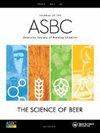基于指纹图谱的静态顶空气相色谱-离子迁移光谱法鉴别果酒
IF 1.8
4区 农林科学
Q4 BIOTECHNOLOGY & APPLIED MICROBIOLOGY
Journal of the American Society of Brewing Chemists
Pub Date : 2021-08-06
DOI:10.1080/03610470.2021.1946654
引用次数: 7
摘要
摘要果果啤酒是一种公认的特殊啤酒,在发酵、成熟或再发酵过程中添加水果制成。采用气相色谱-离子迁移光谱法(GC-IMS)对7种果酒中的挥发性有机物进行了研究。共鉴定出38种化合物,七种啤酒中的挥发物差异很大。壬醛、辛酸甲酯、2-甲基丁酸乙酯、己酸丙酯和2-甲基丁酸甲酯的浓度较高,前两种化合物是菠萝啤酒中的特征挥发物。苹果啤酒中乙酸丁酯、乙酸异丁酯、庚酸甲酯和丁醛的浓度较高。乙酸丁酯是苹果啤酒特有的挥发性物质。桃啤酒中3-甲基丁醛、甲基醛、苯乙醛、α-蒎烯和2,3-二乙基5-甲基吡嗪的含量较高,最后一种仅在桃啤酒中检测到。蔓越莓啤酒中富含庚酸乙酯和麦芽酚,樱桃啤酒中富含芳樟醇、呋喃酮和苯甲醛,苯甲醛是樱桃啤酒特有的挥发性物质。树莓啤酒含有丰富的3-戊酮、丙酸乙酯和E-2-己醇,而蓝莓啤酒则含有丰富的2-羟基丙酸乙酯。主成分分析(PCA)方法对7种果酒进行了有效的判别和分类,具有良好的离散性,并且各组在主成分分析图中都有相应的归属区域。前两个PC的累计贡献率为60%。本研究为果酒中挥发性成分的分析提供了一种方法,有助于验证果酒中的掺假现象。本文章由计算机程序翻译,如有差异,请以英文原文为准。
Discrimination of Fruit Beer Based on Fingerprints by Static Headspace-Gas Chromatography-Ion Mobility Spectrometry
Abstract Fruit beer, a recognized special beer, is produced with fruit addition during fermentation, maturation, or the refermentation process. Volatile organic compounds of seven fruit beers were investigated using a gas chromatography-ion mobility spectrometry (GC-IMS) technique. A total of 38 compounds were identified, and volatiles in the seven beers differed greatly. The concentration of nonanal, methyl octanoate, ethyl 2-methylbutanoate, propyl hexanoate, and methyl 2-methylbutanoate was high, and the first two compounds were the characteristic volatiles in the pineapple beer. Apple beer had a higher concentration of butyl acetate, isobutyl acetate, methyl heptanoate, and butanal. Butyl acetate was the specific apple beer volatile. Peach beer showed a higher concentration of 3-methylbutanal, methional, phenylacetaldehyde, α-pinene as well as 2,3-diethyl 5-methylpyrazine, and the last was detected only in the peach beer. Ethyl heptanoate and maltol were abundant in the cranberry beer, whereas linalool, furaneol, and benzaldehyde were rich in the cherry beer, and benzaldehyde was the characteristic cherry beer volatile. Raspberry beer had abundant 3-pentanone, ethyl propanoate, and E-2-hexenol, whereas blueberry beer had abundant ethyl 2-hydroxypropanoate. Discrimination and classification of the seven fruit beers were effectively performed by the principal component analysis (PCA) method with good dispersion, and all groups had corresponding attribution areas in the PCA map. The cumulative contribution rate of the first two PCs was 60%. This study offers an approach for the analysis of the volatiles of fruit beers and could help in the verification of adulteration in fruit beers.
求助全文
通过发布文献求助,成功后即可免费获取论文全文。
去求助
来源期刊

Journal of the American Society of Brewing Chemists
工程技术-生物工程与应用微生物
CiteScore
4.00
自引率
20.00%
发文量
41
审稿时长
3 months
期刊介绍:
The Journal of the American Society of Brewing Chemists publishes scientific papers, review articles, and technical reports pertaining to the chemistry, microbiology, and technology of brewing and distilling, as well as the analytical techniques used in the malting, brewing, and distilling industries.
 求助内容:
求助内容: 应助结果提醒方式:
应助结果提醒方式:


